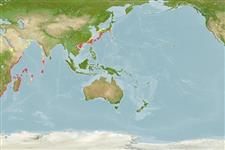Classification / Names
ชื่อสามัญ | ชื่อพ้อง | Catalog of Fishes(สกุล, ชนิด) | ITIS | CoL | WoRMS | Cloffa
>
Pleuronectiformes (Flatfishes) >
Soleidae (Soles)
Etymology: Aseraggodes: Greek, aggos, -eos, -ous = vessel, uterus, carapace of a crab + Greek, aseros, -a, -on = to remove the appetite (Ref. 45335).
Environment: milieu / climate zone / ระดับความลึก / distribution range
นิเวศวิทยา
เกี่ยวกับทะเล,น้ำเค็ม สัตว์น้ำหน้าดิน; ระดับความลึก 6 - 10 m (Ref. 56490). Temperate
Indo-West Pacific: Sodwana Bay (South Africa), Porto Amelia (Mozambique) and Japan.
ขนาด / น้ำหนัก / Age
วัยเจริญพันธุ์: Lm ? range ? - ? cm
Max length : 8.0 cm TL เพศผู้/กระเทย; (Ref. 3200)
Short description
เครื่องมือที่ใช้ในการแยกชนิดสัตว์,สิ่งมีชีวิตออกจากกัน | สัณฐานวิทยา | ความยาวต่างๆ
เงี่ยงครีบหลัง (รวม) : 0; ก้านครีบอ่อนที่หาง (รวม) : 64 - 67; เงี่ยงครีบก้น: 0; ก้านครีบอ่อนที่ก้น: 42 - 44; สัตว์มีกระดูกสันหลัง: 33 - 34. Diagnosis: Dorsal rays 64-67; anal rays 42-44; dorsal and anal rays are not branched. Caudal rays 18, the middle 14 branched. Lateral-line scales of ocular side 64-67; the line extending forward nearly to upper eye, with a ventral branch on head following the edge of the preopercle. Vertebrae 10 + 23-24. Dorsal pterygiophores anterior to fourth neural spine 14-15. Body depth 2.4-2.5 in SL; head length 3.55-3.65 in SL; snout long, 2.6-2.95 in head length; interorbital space narrow, 13.7-20.8 in head length. Caudal peduncle very short, 19.5-23.2 in HL. Tubular anterior nostril anterior to upper edge of lower eye, just reaching cutaneous edge of lower orbit when depressed posteriorly. Two rows of scales in interorbital space, none extending onto medial edges of eyes. Anterior edge of snout of largest specimen (23 mm SL) with a series of 12 conspicuous lappet-like cirri. Ventral margin of head with 20 similar cirri, the longest on chin about equal to pupil diameter; no cirri on opercular edge of either side of gill opening. Jaws of blind side surrounded by a zone of small papillae. Dorsal and anal rays long, the longest dorsal ray 2.5-3.0 in HL. No sheath of scales over base of dorsal and anal fins, at most one row of scales over basal part of rays. Rounded caudal fin and moderately long, 3.2-3.45 in SL. Pelvic fins long, reaching base of third or fourth anal ray, 1.65-1.9 in HL. Color of ocular side when fresh light gray with large irregular dark-edged white spots on head and body, scattered small whitish spots, fewer small black spots, a black spot the size of eye on lateral line in middle of body and a double black spot on lateral line in middle of posterior half of body (Ref. 56490).
Body shape (shape guide): short and / or deep; Cross section: compressed.
Inhabits sand bottoms including reef flats and tide pools in 0-10 m (Ref. 90102).
Life cycle and mating behavior
วัยเจริญพันธุ์ | การสืบพันธุ์ | การวางไข่ | เซลสืบพันธ์ของเพศเมีย(ไข่) | ความดกของไข่ | ตัวอ่อน
Heemstra, P.C. and O. Gon, 1986. Soleidae. p. 868-874. In M.M. Smith and P.C. Heemstra (eds.) Smiths' sea fishes. Springer-Verlag, Berlin. (Ref. 3200)
IUCN Red List Status (Ref. 130435: Version 2025-1)
Threat to humans
Harmless
Human uses
เครื่องมือ
Special reports
Download XML
แหล่งที่มาจากอินเตอร์เน็ต
Estimates based on models
Preferred temperature (อ้างอิง
123201): 23.5 - 28.9, mean 27 °C (based on 509 cells).
Phylogenetic diversity index (อ้างอิง
82804): PD
50 = 0.5000 [Uniqueness, from 0.5 = low to 2.0 = high].
Bayesian length-weight: a=0.00977 (0.00466 - 0.02049), b=3.07 (2.90 - 3.24), in cm total length, based on LWR estimates for this (Sub)family-body shape (Ref.
93245).
ระดับชั้นอาหาร (อ้างอิง
69278): 3.4 ±0.5 se; based on size and trophs of closest relatives
ความสามารถในการกลับคืนสู่ปกติ (อ้างอิง
120179): ความสูง, เวลาต่ำสุดที่จะทำให้ประชากรเพิ่มขึ้นเป็น 2 เท่าใช้เวลาน้อยกว่า 15 เดือน (Preliminary K or Fecundity.).
Fishing Vulnerability (Ref.
59153): Low vulnerability (10 of 100).
🛈
